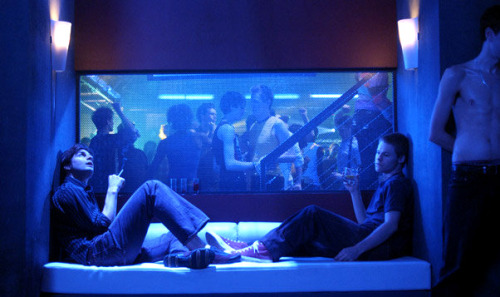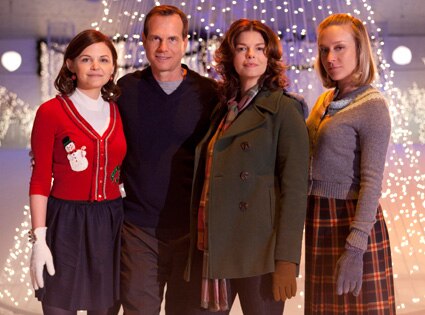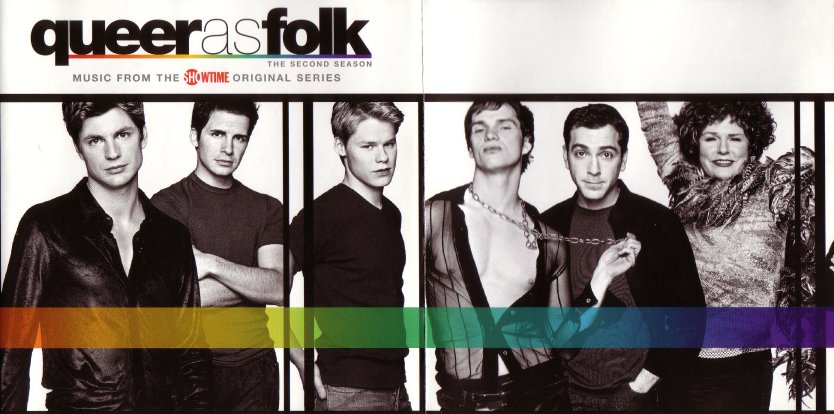A few weeks ago I decided to crash through Big Love for no other reason other than I was bored and figured that it was a random enough choice of show to be my next viewing project. . After getting caught up on Big Love, I was stuck in my "post-marathon withdrawal phase". When you throw yourself into watching a show like I do, essentially spending all the time that I'm not working or doing something for school devouring episode after episode, you kind of feel weird when you finish each experience. Sometimes, if a show is particularly moving, the thought of watching something else can be kind of unappealing. However, probably since Big Love isn't completely over yet, I was actually left unfulfilled, really needing another program.

I'd heard good things about Queer as Folk but never watched it, probably because when it first came out I was twelve and still had parental locks on my television. Hell, I wasn't even allowed to be in the room with my dad when he watched The Sopranos when I was an older teen. Anyway, Queer as Folk became my second marathon viewing session in less than a month's time. I been through 5 seasons in about 6 days aided by the fact that I was completely snowed in at my apartment for the entire week.
I've realized, somewhat amused, that I've just watched two programs back to back that deal with the two "alternative lifestyles" often perceived of as the greatest threats to the "sanctity of marriage", whatever the hell that means. While Big Love centers around the polygamist family of Bill Henrickson and his three wives, Queer as Folk focused on portraying gay and lesbian characters as more than just sassy bit parts. Most would consider these shows to be on absolute opposite ends of the television spectrum at first glance, butit's important to acknowledge what similarities they do have.
- Both made their home on premium cable networks (although Queer as Folk was born on UK television). These are shows that are not available to the mass American audience unless they are subscribers to Showtime or HBO. Both networks are known for groundbreaking television, but at the end of the day any dirt they may have stirred up has been quarantined away from the mass audience.
- Sexuality is an important part of telling the story. Queer as Folk never held back on sex scenes or sexual situations on purpose. It was a way to make the characters step out of the typical asexual roles most gay characters had always been on television. On Big Love, sexuality is often used as a question mark. If you meet one of your wives for a secret rendezvous, is that an affair? Most of all, on both programs, the main point seemed to be people have sex...deal with it.
- While every story ever conceived has at least one strong setting, Big Love and Queer as Folk put great importance on the communal meeting ground. Big Love has the backyard between the three houses each wife lives in. Weddings, family dinners, baptisms, stolen kisses, and overheard conversations all happen poolside. Queer as Folk had Babylon, the gay club the boys met at almost every night with its "thumpa thumpa" music.
- Queer as Folk and Big Love both tell the story of people just outside of the mainstream trying to function on Main Street, but even within their own community each individual has a different opinion on where their futures should be within a monogamous and straight world. While Brian Kinney scoffs at the point of gay marriage, his best friend gets married in Toronto where it's legal for him and his partner to do so. Bill Henrickson would prefer his family assimilate into the rest of Utah's society, Alby Grant prefers to keep his life and his religion on polygamist compounds.
All of these similarities produce an interesting question. Is Big Love really a story about polygamy and Queer as Folk merely a look into the gay life? Of course not. The shows are sequestered away from a larger audience like the people they're about, both intensely sexual in order to remind us of a common thread of human intimacy. Underlined in a strong community center of shared experiences with individual opinions, both Queer as Folk and Big Love challenge their audience to comprehend in order to understand, to understand in order to find acceptance.
Whatever criticisms exist regarding the content or accuracy of either show, it must be said that both are necessary in the television landscape, because entertainment can influence attitudes in impressive speeds. The world is too big, and and our time on it too small, to focus on judging others. In fact, in our world, people like Brian Kinney and people like Bill Henrickson have things in common. Also, frankly, shows like these keep television interesting and evolving. There are so many stories that haven't been told and so many we've repeated to death. Kudos to those who try and change that.






Bravo.. to my favorite Lindsay in the whole wide world
ReplyDelete